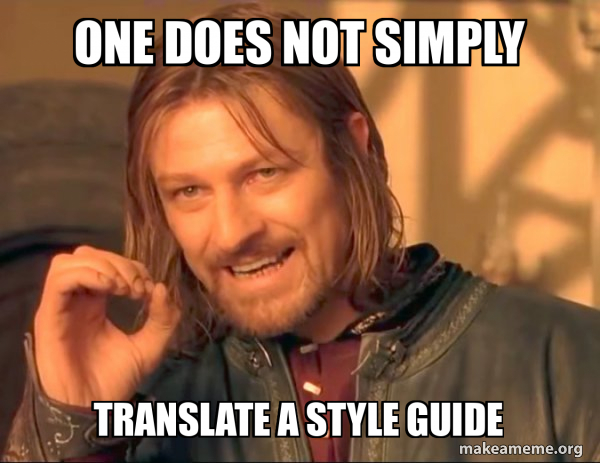One does not simply translate a style guide

„Do you already have a German style guide and TOV document?“, I asked a potential client.
„No, but I can send you the English ones. Can‘t you just translate them?“
No. Well yes, I could of course. But it doesn’t make sense and would be a waste of time and money.
Style guide translation
Simply translating a style guide means:
- Important topics are not included. In the case of German, the copywriter or translator needs to know how you want to address your readers: “du” or “Sie”? Both are “you” in English, so you probably don’t even answer the question in your style guide, and if you did, a simple translation would run into the same problem.
- There’s irrelevant information in it, for example if you prefer to use “realize” or “realise” and how you stand on the Oxford comma. Your German writing team will stick to standard German spelling and punctuation anyway.
- Some of the information will be incomplete. If you say “use gender-neutral language where possible”, that might be enough for your English content team. But German is an inherently gendered language. If you write “teacher”, we have to translate it either in the male form “Lehrer”, or the female “Lehrerin”. There are different ways to include all genders, but we would have to know if you want to use “Lehrer oder Lehrerin”, “LehrerIn”, “Lehrer:in”, “Lehrer*in” or “Lehrende”.
-> The best solution is to create a German style guide from scratch. The English one can be used as a basis, but it will need to be adapted by your German language expert with input from you (and your market research team, if you have one), so expect to be asked many questions. If they are culturally aware, they will know how to explain the options so together you can create a document that actually helps your content team.
Tone of voice translation
Translating a tone of voice document has less tangible problems, but they are there just the same.
For example, telling your content creators you want to sound “quirky, yet reliable” might work in English, but simply translating that would leave your German writing team wondering what you mean. And the tone might not resonate with German readers in the same way, because they probably need it to be a bit more “serious” in order to part with their money.
So, what to do?
You need to do market research to find out which TOV works with your intended audience. Or you need a cultural advisor (who might also be your translator) to find solutions that work for the German readers while still sounding like your brand.
If all this leaves you a bit overwhelmed, talk to me. I can help.